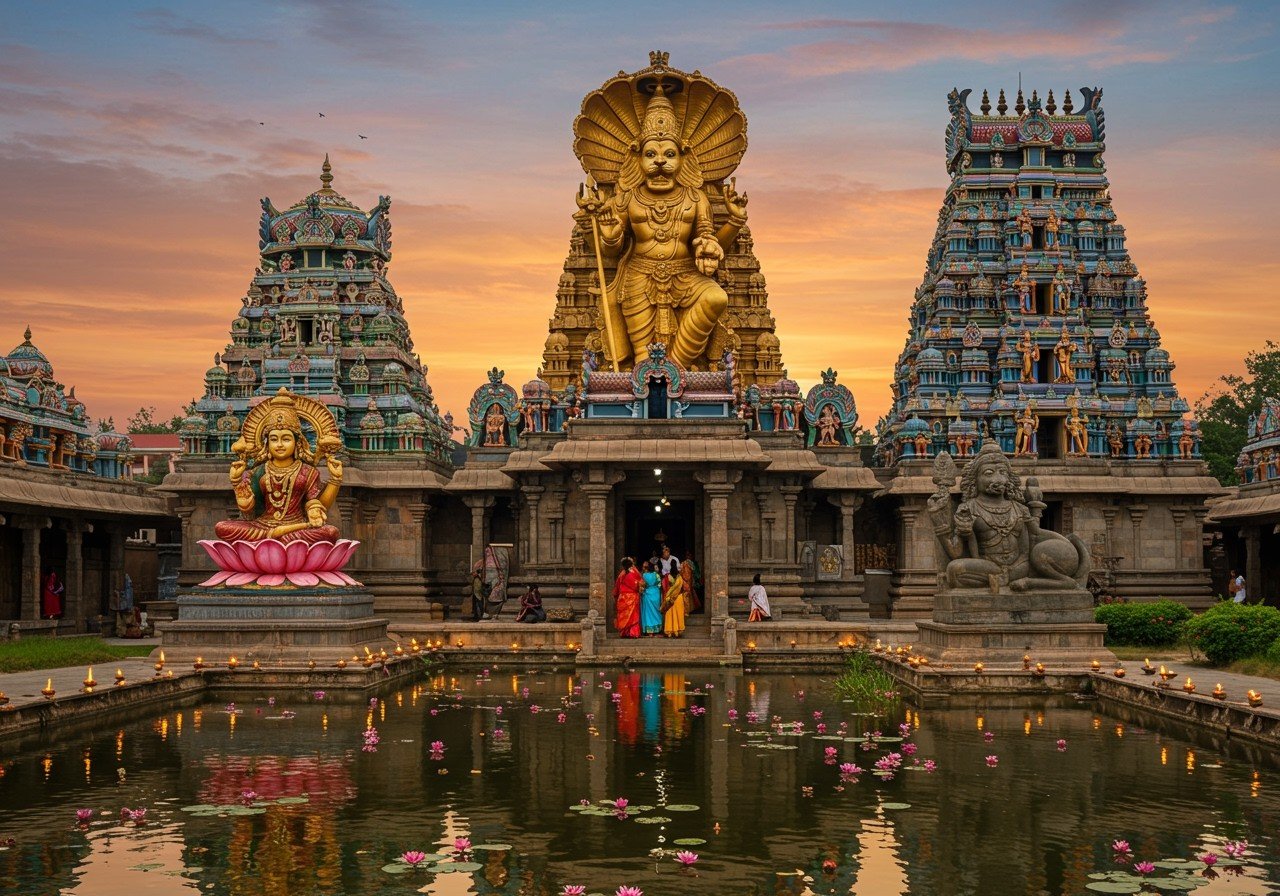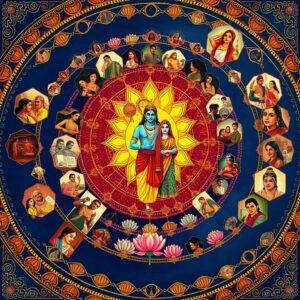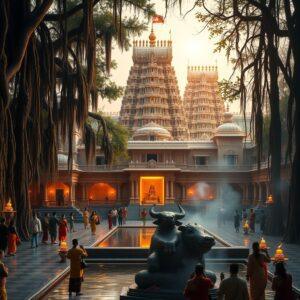Varaha Lakshmi Narasimha Temple: A Comprehensive Guide

Nestled in the heart of Simhachalam, Andhra Pradesh, the Varaha Lakshmi Narasimha Temple stands as a revered sanctuary for devotees of Lord Vishnu. This sacred site, dedicated to the unique manifestation of Varaha Narasimha, captivates visitors with its distinctive blend of architectural styles and profound historical significance. Attracting countless devotees and tourists year-round, meticulous planning is key to a fulfilling visit. This guide offers essential insights into the temple’s timings, location, travel tips, and more.
Delving into History
The Varaha Lakshmi Narasimha Temple boasts a rich history, tracing its origins back to the 11th century. Constructed during the reign of the Eastern Ganga kings, this temple exemplifies ancient South Indian architectural prowess. Its prominence in Hindu mythology is underscored by mentions in numerous ancient scriptures. The presiding deity, Varaha Narasimha, represents a unique fusion of two of Lord Vishnu’s avatars – Varaha (boar) and Narasimha (lion-man), a combination rarely found elsewhere, enhancing its significance as a pilgrimage site. Inscriptions from various dynasties, including the Cholas and Vijayanagara Empire, further illuminate its historical relevance.
Architectural Splendor
The temple’s architecture showcases a harmonious blend of Orissan and Chalukyan styles, evident in the intricately carved stone pillars, ornate doorways, and exquisite sculptures. Within the main sanctum, the deity remains veiled in sandalwood paste throughout the year, with the exception of Akshaya Tritiya, when its true form is revealed to devotees. The temple complex encompasses a Kalyana Mandapam (marriage hall), adorned with elaborately carved pillars depicting scenes from mythology. The outer walls are embellished with sculptures of deities, animals, and floral motifs, a testament to the artisans’ skill. The towering gopuram (temple tower) stands as a prominent landmark, visible from afar.
Planning Your Visit: Timings and Ideal Time
The temple welcomes devotees from 7:00 AM to 4:00 PM and 6:00 PM to 9:00 PM daily. A visit during the early morning hours is recommended for a tranquil darshan, avoiding the midday crowds. Festivals such as Narasimha Jayanti and Vaikuntha Ekadashi witness a surge in visitors. Akshaya Tritiya holds special significance as the day the deity’s original form is unveiled, drawing throngs of devotees. The period from October to March offers the most pleasant weather for a visit, while the peak summer months (April to June) are best avoided due to the region’s high temperatures.
Travel Tips: Getting There and Accommodation
Simhachalam enjoys excellent connectivity by road, rail, and air. Visakhapatnam Airport, approximately 18 kilometers away, serves as the nearest airport. From Visakhapatnam, taxis and buses are readily available to reach the temple. The Simhachalam railway station is the closest railhead, connected to major cities by regular train services. For those traveling by road, National Highway 16 provides access to Simhachalam. A range of accommodation options, from budget-friendly lodges to comfortable hotels, can be found near the temple. Advance booking is recommended, particularly during festival times.
Rituals and Festivals
The temple adheres to a strict schedule of daily rituals, including Suprabhatam (early morning prayers), Abhishekam (ritual bathing), and Alankaram (adorning the deity). Devotees can partake in special sevas (services) like Archana (chanting of divine names), Kalyanotsavam (symbolic marriage ceremony), and Sahasranama Archana (recitation of a thousand names). Major festivals celebrated with fervor include Narasimha Jayanti, Brahmotsavam, and Vaikuntha Ekadashi. During these festivities, the temple is resplendent with decorations, and special rituals are performed. The Rathotsavam (chariot festival) is a highlight, featuring a grand procession of the deity.
Nearby Attractions
Extend your visit to explore nearby attractions such as Kailasagiri, a hilltop park offering panoramic views of Visakhapatnam. The Simhachalam Devasthanam maintains a serene garden and a small zoo, ideal for a relaxing stroll. Ramakrishna Beach beckons visitors to enjoy leisurely walks and breathtaking sunsets. The Submarine Museum, situated on the beach road, offers a unique experience. Nature enthusiasts can explore the Kambalakonda Wildlife Sanctuary, known for trekking and wildlife sightings.
Enhance Your Spiritual Journey with Poojn.in
Prepare for your visit to the Varaha Lakshmi Narasimha Temple with sacred essentials from Poojn.in, India’s leading online store for puja samagri. We provide a wide selection of high-quality puja items, including pure copper kalash, brass diyas, and more, delivered conveniently to your doorstep. Our curated puja kits for Narasimha worship ensure you have everything needed for a reverent experience. Elevate your spiritual journey with Poojn.in.
Frequently Asked Questions: Varaha Lakshmi Narasimha Temple
What are the temple timings?
The temple is open from 7:00 AM to 4:00 PM and 6:00 PM to 9:00 PM. Timings may vary during festivals.
Where is the temple located?
The temple is situated in Simhachalam, approximately 18 kilometers from Visakhapatnam city center.
How can I reach the temple?
The temple is accessible by road, rail, and air. Visakhapatnam Airport is the nearest airport. Simhachalam has its own railway station, and well-connected roads facilitate travel by bus or private vehicle.
Concluding Thoughts
A visit to the Varaha Lakshmi Narasimha Temple is an enriching spiritual sojourn. This guide equips you with the necessary information for a seamless and fulfilling experience. The temple’s rich history, captivating architecture, and serene ambiance make it a must-visit destination. Embrace the traditions, participate in the rituals, and immerse yourself in the divine aura of this sacred place. May your visit be blessed with divine grace and cherished memories.


